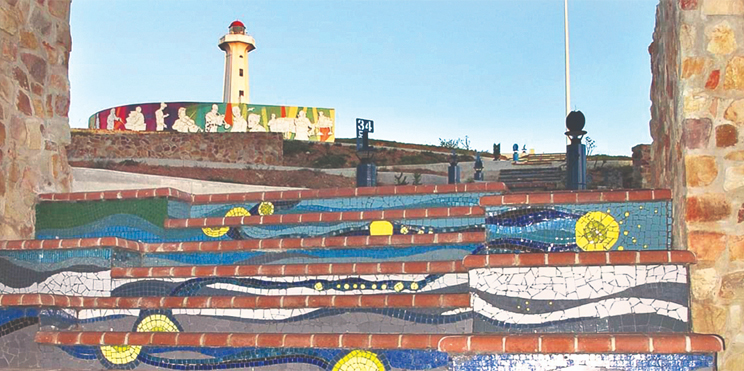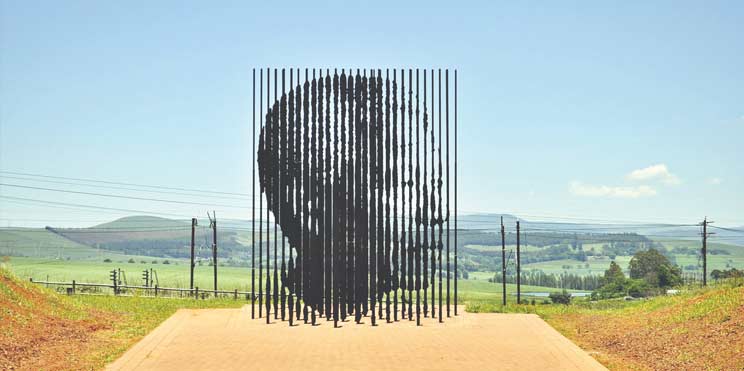On the centenary year of South Africa’s iconic hero Nelson Mandela, we explore Route 67, located mainly in the city of Port Elizabeth, consisting of 67 public artworks that symbolise 67 years of the leader’s political life and work dedicated to freedom struggle of South Africa.
Port Elizabeth or just PE, if you say it like a local, is South Africa’s fifth largest city. It is located on the Indian Ocean coast, half-way between Cape Town and Durban, in the Eastern Cape province. Also known as the ‘friendly city’ and the ‘windy city,’ PE lives up to both names. The picturesque city falls under the territory of Nelson Mandela Bay Municipality area and houses a large part of Route 67, a trail designed for those who love to explore South African history and heritage.
“The metropole of Nelson Mandela Bay is named after the late South African President and Nobel Peace Prize recipient whom we fondly call Madiba, as this land was his birthplace. The saga of the legend and his legacy is written all over this place,” says Done Louw from Nelson Mandela Bay Tourism.
The Mandela Bay Development Authority’s Route 67 consists of 67 public artworks dedicated to the freedom of South Africa and includes 67 steps leading up the second largest flag in Africa. The artworks were designed by local artists from the Eastern Cape, and some are still under progress.
“Route 67 is best explored via a guided walking tour. All the information of the Route 67 guided tours conducted by the registered tour companies is available at the Donkin Visitor Information Office inside the lighthouse building,” says Neliswa Nkani – Hub Head, Middle East, India & South East Asia, South African Tourism.
Starting at an old city icon, the Campanile Monument, the Route 67 ducks under flyovers and climbs a staircase to Vuyisile Mini Square, the centre of the city. Then squeezing through the staircase at St Mary’s, it erupts in a celebration of colour, art and heritage that meanders up the Donkin to the great flag at the top of the hill. From here the journey continues along the old streets of the city past art galleries and parks to then culminate at the Nelson Mandela Metropolitan Art Museum. Route 67 also reaches further, linking the journey in Uitenhage, South End and The Red Location Precinct.
One of the most remarkable elements of Route 67 is the massive mosaic at the base of the pyramid. Stroll about this outdoor display and you’ll be exposed to the best elements of the Eastern Cape: the province’s indigenous people, the settlers, modern-day sports personalities, Karoo scenes complete with windmills and springbok, nautical settings, and even modern-day traffic circles. Then take a stroll down the coloured steps past posted artworks that continue to tell the South African story. Look back up at the lighthouse and you’ll see a wall adorned with an assortment of figures: taxi passengers, newspaper vendors and jazz trumpeters, to name a few. If you need a breather at this point, pay a visit to the Phoenix Hotel. Dating back to 1837, this old watering hole is packed with enough collectables, photos and memorabilia to provide talking points for a couple of rounds at least.
“A lot of Indian tourists are finding it extremely interesting to take this experience in groups. And as you stand next to a celebrating Mandela, raise your fist just like him and wish the city of Port Elizabeth and its people good luck and take that picture back with you,” concludes Neelam Bhonsle of Misba Holidays, an outbound tour operator from Mumbai.
HIGHLIGHTS OF ROUTE 67
Though all 67 of the public artworks are masterpieces in their own right, some of them find a special place in the heart of the South African people and are more popular among the tourists.
1 Way Finding Markers: Starts at the Campanile in the city and the Donkin Reserve to the Nelson Mandela Metropolitan Museum
2 Campanile Frieze: A celebration of the indigenous heritage of the land is sculpted through visual images set into a cast concrete curved beam
3 Wall of texts: A written flow-poem engraved onto locally-sourced granite accompanies the Campanile Frieze and celebrates the indigenous art and culture
5 Talking Woman 2: Using colour glass, oxides and powders this female figure was created as a symbol of what women have that unites them rather than what divides them
7-16 Identities: A series of evocative portraits that depict young South Africans from a range of cultural backgrounds are installed on the pillars underneath the Settlers Way flyovers
30 Fishbone: The Fishbone is an architectural element intended to visually anchor the old Jerry Street to Vuyisile Mini Square and encourage pedestrians to trace a historical path between the city and the harbour
34 Chapel Street Crossing: A pattern of colourful paving bricks flow from all directions over the crossing in Chapel Street representing the gathering of masses that are voted in the 1994 elections
35 Tower Sculpture: It acts as a beacon to announce the journey through the Donkin Reserve and responds to the surrounding elements to allow wind and light to bring it to life
36 Mosaic Stairs: The stairway is an experimental journey that starts in darkness and turbulence and progresses to a new dawn and explosion of colour, hope and new beginnings
42 Piazza Mosaic: This 470 square metre mosaic, situated between the Pyramid and the Great Flag celebrates the multicultural, the heritage, the diverse histories and abundant fauna and flora that characterises the city and the province
43 Great Flag: The biggest South African flag with 65m high flagpole sits within the Arts Journey in Port Elizabeth as a point in space that marks the Donkin Reserve as an important public space and celebration of the Port Elizabeth city’s heritage
44 Voting Line: The life-size laser-cut steel figures form a symbolic voting line that evokes a memory of voters as they were seen in the country’s first democratic elections in 1994
45 Windward: The shapes of these sculptural benches hint at Port Elizabeth’s nautical history while the title refers to the city’s popular name, the “Windy City” graffiti
48 Welcome Carpet: The artwork is a welcoming celebration and luxurious experience hinting at the cultural context of the Eastern Cape and leading diverse local cultures
55 artEC Sculpture Courtyard: The basic concept and underlying icon is woven into this piece which is one of the waves that ties us all together and rolls onwards through history in the making of contemporary times
56 67 Beaded Quotes: This is a series of artworks as a direct response by 30 beaders from the Eastern Cape to 67 quotes by Nelson Mandela over the last 67 years narrating South Africa’s challenges
63 South End Glass Sculpture: A sculpture created to commemorate the people who were forcefully removed from the old South End by the Group Areas Act under the Apartheid laws
67 Guernica: By community collaboration, this work bears eloquent witness to the ongoing painful struggle of rural communities dealing with the AIDS epidemic

